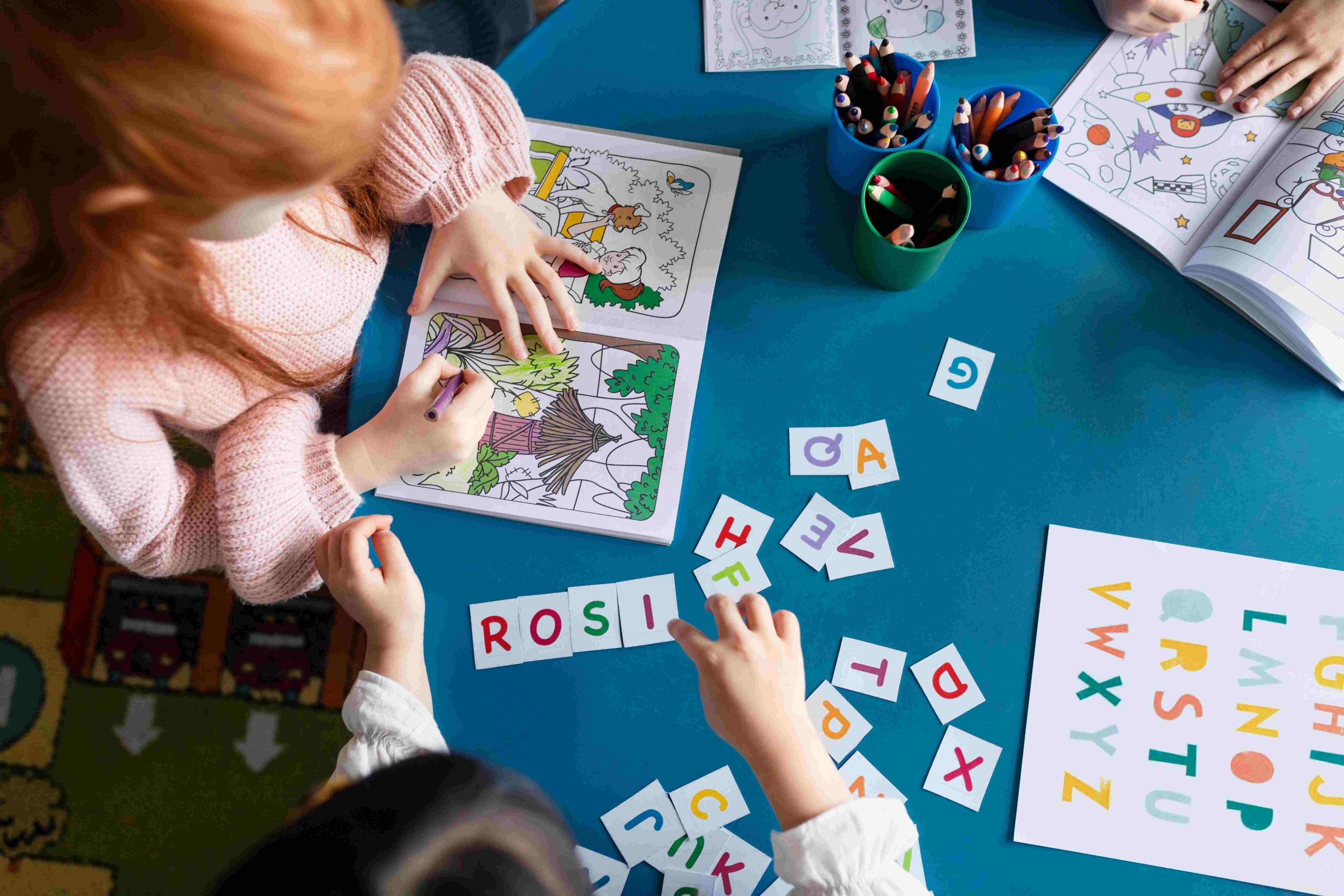Nurturing Print Awareness Skills in Preschoolers: Unlocking a World of Literacy
Creating a Print-Rich Environment
Creating a print-rich environment is an essential first step in nurturing print awareness skills in preschoolers. Surrounding preschoolers with written language in their everyday surroundings helps them recognize the purpose and significance of print. Consider the following strategies to cultivate a print-rich environment:
Labeling: Labeling objects in the preschool environment, such as tables, chairs, shelves, and toys, provides valuable opportunities for preschoolers to make connections between spoken words and their written counterparts.
Word Walls: Displaying word walls featuring commonly used words can help preschoolers become familiar with the written forms of these words. Encourage preschoolers to actively engage with the word wall by locating and tracing the words.
Reading Corners: Establish cozy reading corners filled with a variety of age-appropriate books. Ensure that books are easily accessible, inviting preschoolers to explore them independently.
Interactive Read-Alouds
Interactive read-aloud sessions offer a powerful platform for fostering print awareness skills in preschoolers. Engaging in interactive discussions during shared reading experiences helps preschoolers grasp the fundamental concepts of print. Here are some strategies to enhance interactive read-alouds:
Pointing to Words: While reading aloud, use your finger to track the words on the page. This simple action draws preschoolers’ attention to the connection between spoken words and written text.
Predicting and Questioning: Encourage preschoolers to make predictions about the story and ask questions along the way. This promotes active engagement and encourages preschoolers to think critically about the text.
Word Play: Introduce playful activities that focus on letter and sound recognition. For instance, invite preschoolers to find words that begin with a specific sound or letter in the story.
Alphabet Awareness and Letter Knowledge
Developing alphabet awareness and letter knowledge is a crucial aspect of print awareness skills. Preschoolers need to recognize and understand letters before they can grasp the concept of words and sentences. Consider the following strategies for promoting alphabet awareness and letter knowledge:
Alphabet Songs and Rhymes: Engage preschoolers in lively alphabet songs and rhymes that reinforce letter recognition. Encourage them to sing along and identify letters as they appear in the song.
Alphabet Crafts: Plan hands-on craft activities where preschoolers can create letter-themed art. For example, they can make collages using pictures cut from magazines that begin with specific letters.
Letter Tracing and Formation: Provide opportunities for preschoolers to practice tracing and forming letters using a variety of sensory materials such as sand, playdough, or finger paints. This multi-sensory approach enhances letter recognition and strengthens fine motor skills.
Environmental Print Exploration
Exploring environmental print in the world around us can be an engaging way for preschoolers to apply their print awareness skills. Everyday items like signs, labels, and logos provide real-world context for understanding print. Here are some strategies to encourage exploration of environmental print:
Print Walks: Take preschoolers on print walks around the school or local community, pointing out and discussing different types of print they encounter. Encourage them to identify familiar logos and signs.
Shopping List Adventures: During pretend play activities, provide preschoolers with shopping lists to enhance their familiarity with written words. They can practice finding items in the classroom or play area based on the written list.
Post Office Pretend Play: Set up a pretend post office area where preschoolers can engage in activities such as sorting and delivering mail. This immersive experience exposes them to print in a meaningful and enjoyable way.
Word and Sentence Awareness
Building word and sentence awareness is an integral part of print awareness development in preschoolers. Understanding the basic units of language and how they come together to form meaning is essential for reading comprehension. Here are some strategies to promote word and sentence awareness:
Word Hunts: Engage preschoolers in word hunts where they search for specific words in books or environmental print. Encourage them to identify and highlight the target words, fostering their ability to recognize words in different contexts.
Sentence Building: Provide preschoolers with word cards or sentence strips and encourage them to arrange the words in the correct order to form meaningful sentences. This activity enhances their understanding of sentence structure and word order.
Sentence Puzzles: Create sentence puzzles by cutting sentences into individual words or phrases. Preschoolers can then assemble the puzzle pieces to recreate the original sentence, developing their comprehension of sentence construction.
Print-Related Games and Activities
Integrating print-related games and activities into daily routines adds an element of fun and engagement to print awareness skill development. Consider the following ideas for interactive and enjoyable learning experiences:
Alphabet Scavenger Hunt: Hide letters around the classroom or outdoor area and challenge preschoolers to find and identify them. Encourage them to name the letters and their corresponding sounds as they discover them.
Word Bingo: Create bingo cards featuring words that preschoolers have been learning. Call out the words and have them mark the corresponding word on their bingo cards. This activity reinforces word recognition and vocabulary development.
Storytelling with Props: Provide props or picture cards related to a familiar story. Encourage preschoolers to use the props to retell the story, reinforcing their understanding of narrative structure and sequencing.
Engaging Technology and Digital Resources
In today’s digital age, technology can be a valuable tool to support print awareness skill development in preschoolers. Carefully selected digital resources can provide interactive and engaging learning experiences. Consider the following guidelines for incorporating technology into print awareness activities:
Interactive Story Apps: Choose interactive story apps that allow preschoolers to engage with the text, such as tapping on words to hear them read aloud or playing interactive games related to the story. This helps reinforce print concepts and comprehension skills.
Letter and Word Recognition Games: Explore educational apps or online games that focus on letter and word recognition. These interactive activities can provide additional practice and reinforcement of print awareness skills.
Virtual Field Trips: Take virtual field trips to places such as museums, zoos, or libraries, where preschoolers can engage with print-rich environments and explore different forms of written language.
Language-Rich Conversations
Language-rich conversations play a crucial role in developing print awareness skills in preschoolers. Engaging in meaningful discussions exposes preschoolers to a variety of vocabulary, sentence structures, and the nuances of language. Here are some strategies to promote language-rich conversations:
Open-Ended Questions: Pose open-ended questions that encourage preschoolers to express their thoughts and opinions. This promotes active listening, critical thinking, and expands their language abilities.
Vocabulary Expansion: Introduce new words during conversations and provide explanations or synonyms to expand their vocabulary. Encourage preschoolers to use the new words in their own sentences to reinforce understanding.
Story Retelling: After reading a story together, encourage preschoolers to retell the story using their own words. This activity develops narrative skills, comprehension, and the ability to structure and organize thoughts.
Writing Experiences
While print awareness primarily focuses on reading, incorporating writing experiences into a preschooler’s learning journey is equally important. Writing activities help preschoolers understand the connection between spoken and written language and further strengthen their print awareness skills. Consider the following strategies for encouraging writing experiences:
Scribbling and Drawing: Provide ample opportunities for preschoolers to engage in scribbling and drawing activities. These early writing experiences help them understand that marks on a page convey meaning and lay the groundwork for letter formation.
Writing Centers: Set up writing centers equipped with a variety of writing materials, including pencils, crayons, markers, and paper. Encourage preschoolers to engage in independent writing, whether it’s drawing pictures, making scribbles, or attempting to write letters or words.
Dictated Stories: Encourage preschoolers to dictate stories or ideas to an adult or a peer who can transcribe their words onto paper. This activity reinforces the idea that spoken words can be transformed into written text.
Parent and Community Involvement
Collaboration between educators, parents, and the wider community plays a vital role in supporting print awareness skill development in preschoolers. By involving parents and tapping into community resources, we create a holistic approach to nurturing print awareness. Consider the following strategies for parent and community involvement:
Parent Workshops: Conduct workshops or information sessions for parents to educate them about the importance of print awareness skills and provide practical strategies for supporting their child’s literacy development at home.
Community Library Visits: Organize visits to local libraries where preschoolers can engage with books, participate in storytelling sessions, and borrow age-appropriate books to enjoy at home. This exposes them to a variety of print materials and fosters a love for reading.
Collaborative Projects: Collaborate with community members, such as local businesses or organizations, to create print-rich projects or initiatives. For example, partner with a local bookstore to host storytelling events or display preschoolers’s artwork in their establishment.
Assessment and Progress Monitoring
Assessment and progress monitoring are essential components of supporting and evaluating preschoolers’ print awareness skills. Regular assessment allows educators and parents to identify areas of strength and areas that need further development. Consider the following strategies for effective assessment and progress monitoring:
Observational Assessments: Observe preschoolers during various print-related activities, such as shared reading sessions, writing experiences, or word recognition tasks. Note their engagement, understanding, and application of print awareness skills.
Portfolio Development: Create portfolios for each child, documenting their progress in print awareness skills over time. Include samples of their writing, drawings, and other print-related activities to track their growth and identify areas for further support.
Informal Assessments: Utilize informal assessments, such as letter and word recognition tasks or matching activities, to gather data on specific print awareness skills. These assessments can be conducted individually or in small groups to gauge individual progress.
Differentiated Instruction
Preschoolers have diverse learning needs and abilities, and it is crucial to provide differentiated instruction to meet their individual requirements. By tailoring instruction to their specific strengths and challenges, we can effectively support their print awareness skill development. Consider the following strategies for differentiated instruction:
Small Group Activities: Organize small group activities that target specific print awareness skills based on individual needs. For example, one group may focus on letter recognition while another group engages in sentence-building activities.
Flexible Reading Levels: Provide books and reading materials at different levels of difficulty to accommodate varying reading abilities. This allows preschoolers to engage with text that aligns with their current skill level, ensuring meaningful and successful reading experiences.
Individualized Support: Offer individualized support and scaffolding for preschoolers who require additional assistance in developing print awareness skills. This can include one-on-one guided reading sessions, explicit instruction on letter formation, or tailored writing activities.
Professional Development and Collaboration
Continued professional development and collaboration among educators are crucial in effectively nurturing print awareness skills in preschoolers. By staying updated on current research and sharing best practices, educators can enhance their instructional strategies and provide high-quality print awareness instruction. Consider the following strategies for professional development and collaboration:
Professional Workshops and Conferences: Attend workshops and conferences focused on early literacy and print awareness. These events provide opportunities to learn from experts, share ideas with colleagues, and gain valuable insights into effective instructional strategies.
Professional Learning Communities: Foster professional learning communities where educators can collaborate, share resources, and discuss effective print awareness practices. Regular meetings and discussions allow for reflection and refinement of instructional approaches.
Peer Observation and Feedback: Encourage peer observation and feedback among educators to promote a culture of continuous improvement. By observing colleagues’ instructional practices, educators can gain new perspectives and refine their own teaching techniques.
Cultivating a Love for Reading
Fostering a love for reading is a vital aspect of developing print awareness skills in preschoolers. When preschoolers develop a genuine passion for books and reading, they become motivated to explore and engage with print in various forms. Consider the following strategies for cultivating a love for reading:
Read-Alouds with Expression: Infuse read-aloud sessions with enthusiasm and expressive storytelling. Use different voices for different characters, incorporate gestures and facial expressions, and create a captivating atmosphere that sparks preschoolers’ imaginations.
Book Discussions: Engage preschoolers in discussions about the books they read. Encourage them to share their thoughts, opinions, and favorite parts of the story. This encourages active participation and a deeper connection with the text.
Book Choice and Access: Provide a wide selection of books that cater to diverse interests and reading levels. Allow preschoolers to choose books based on their preferences, empowering them to take ownership of their reading experiences.
Book-related Activities: Extend the reading experience by incorporating book-related activities such as creating artwork inspired by a story, role-playing scenes from a book, or engaging in dramatic retellings. These activities deepen the connection between reading and real-world experiences.



